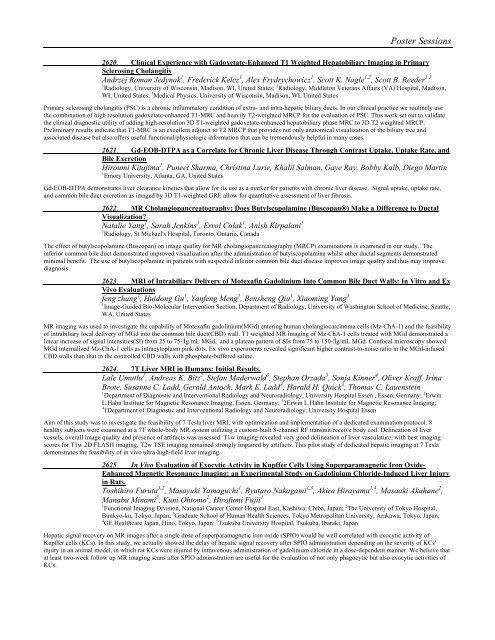TRADITIONAL POSTER - ismrm
TRADITIONAL POSTER - ismrm
TRADITIONAL POSTER - ismrm
You also want an ePaper? Increase the reach of your titles
YUMPU automatically turns print PDFs into web optimized ePapers that Google loves.
Poster Sessions<br />
2620. Clinical Experience with Gadoxetate-Enhanced T1 Weighted Hepatobiliary Imaging in Primary<br />
Sclerosing Cholangitis<br />
Andrzej Roman Jedynak 1 , Frederick Kelcz 1 , Alex Frydrychowicz 1 , Scott K. Nagle 1,2 , Scott B. Reeder 1,3<br />
1 Radiology, University of Wisconsin, Madison, WI, United States; 2 Radiology, Middleton Veterans Affairs (VA) Hospital, Madison,<br />
WI, United States; 3 Medical Physics, University of Wisconsin, Madison, WI, United States<br />
Primary sclerosing cholangitis (PSC) is a chronic inflammatory condition of extra- and intra-hepatic biliary ducts. In our clinical practice we routinely use<br />
the combination of high resolution gadoxetate-enhanced T1-MRC and heavily T2-weighted MRCP for the evaluation of PSC. This work set out to validate<br />
the clinical diagnostic utility of adding high-resolution 3D T1-weighted gadoxetate-enhanced hepatobiliary phase MRC to 3D T2 weighted MRCP.<br />
Preliminary results indicate that T1-MRC is an excellent adjunct to T2 MRCP that provides not only anatomical visualization of the biliary tree and<br />
associated disease but also offers useful functional/physiologic information that can be tremendously helpful in many cases.<br />
2621. Gd-EOB-DTPA as a Correlate for Chronic Liver Disease Through Contrast Uptake, Uptake Rate, and<br />
Bile Excretion<br />
Hiroumi Kitajima 1 , Puneet Sharma, Christina Lurie, Khalil Salman, Gaye Ray, Bobby Kalb, Diego Martin<br />
1 Emory University, Atlanta, GA, United States<br />
Gd-EOB-DTPA demonstrates liver clearance kinetics that allow for its use as a marker for patients with chronic liver disease. Signal uptake, uptake rate,<br />
and common bile duct excretion as imaged by 3D T1-weighted GRE allow for quantitative assessment of liver fibrosis.<br />
2622. MR Cholangiopancreatography: Does Butylscopolamine (Buscopan®) Make a Difference to Ductal<br />
Visualization?<br />
Natalie Yang 1 , Sarah Jenkins 1 , Errol Colak 1 , Anish Kirpalani 1<br />
1 Radiology, St Michael's Hospital, Toronto, Ontario, Canada<br />
The effect of butylscopolamine (Buscopan) on image quality for MR cholangiopancreatography (MRCP) examinations is examined in our study. The<br />
inferior common bile duct demonstrated improved visualization after the administration of butylscopolamine whilst other ductal segments demonstrated<br />
minimal benefit. The use of butylscopolamine in patients with suspected inferior common bile duct disease improves image quality and thus may improve<br />
diagnosis.<br />
2623. MRI of Intrabiliary Delivery of Motexafin Gadolinium Into Common Bile Duct Walls: In Vitro and Ex<br />
Vivo Evaluations<br />
feng zhang 1 , Huidong Gu 1 , Yanfeng Meng 1 , Bensheng Qiu 1 , Xiaoming Yang 1<br />
1 Image-Guided Bio-Molecular Intervention Section, Department of Radiology, University of Washington School of Medicine, Seattle,<br />
WA, United States<br />
MR imaging was used to investigate the capability of Motexafin gadolinium(MGd) entering human cholangiocarcinoma cells (Mz-ChA-1) and the feasibility<br />
of intrabiliary local delivery of MGd into the common bile duct(CBD) wall. T1 weighted MR imaging of Mz-ChA-1 cells treated with MGd demonstrated a<br />
linear increase of signal intensities(SI) from 25 to 75-¦Ìg/mL MGd, and a plateau pattern of SIs from 75 to 150-¦Ìg/mL MGd. Confocal microscopy showed<br />
MGd internalized Mz-ChA-1 cells as intracytoplasm pink dots. Ex vivo experiments revealed significant higher contrast-to-noise ratio in the MGd-infused<br />
CBD walls than that in the controlled CBD walls with phosphate-buffered saline.<br />
2624. 7T Liver MRI in Humans: Initial Results.<br />
Lale Umutlu 1 , Andreas K. Bitz 2 , Stefan Maderwald 3 , Stephan Orzada 3 , Sonja Kinner 4 , Oliver Kraff, Irina<br />
Brote, Susanne C. Ladd, Gerald Antoch, Mark E. Ladd 3 , Harald H. Quick 3 , Thomas C. Lauenstein<br />
1 Department of Diagnostic and Interventional Radiology and Neuroradiology, University Hospital Essen , Essen, Germany; 2 Erwin<br />
L.Hahn Institute for Magnetic Resonance Imaging, Essen, Germany; 3 2Erwin L.Hahn Institute for Magnetic Resonance Imaging;<br />
4 1Department of Diagnostic and Interventional Radiology and Neuroradiology, University Hospital Essen<br />
Aim of this study was to investigate the feasibility of 7 Tesla liver MRI, with optimization and implementation of a dedicated examination protocol. 8<br />
healthy subjects were examined at a 7T whole-body MR system utilizing a custom-built 8-channel RF transmit/receive body coil. Delineation of liver<br />
vessels, overall image quality and presence of artifacts was assessed. T1w imaging revealed very good delineation of liver vasculature, with best imaging<br />
scores for T1w 2D FLASH imaging. T2w TSE imaging remained strongly impaired by artifacts. This pilot study of dedicated hepatic imaging at 7 Tesla<br />
demonstrates the feasibility of in vivo ultra-high-field liver imaging.<br />
2625. In Vivo Evaluation of Exocytic Activity in Kupffer Cells Using Superparamagnetic Iron Oxide-<br />
Enhanced Magnetic Resonance Imaging; an Experimental Study on Gadolinium Chloride-Induced Liver Injury<br />
in Rats.<br />
Toshihiro Furuta 1,2 , Masayuki Yamaguchi 1 , Ryutaro Nakagami 1,3 , Akira Hirayama 1,4 , Masaaki Akahane 2 ,<br />
Manabu Minami 5 , Kuni Ohtomo 2 , Hirofumi Fujii 1<br />
1 Functional Imaging Division, National Cancer Center Hospital East, Kashiwa, Chiba, Japan; 2 The University of Tokyo Hospital,<br />
Bunkyo-ku, Tokyo, Japan; 3 Graduate School of Human Health Sciences, Tokyo Metropolitan University, Arakawa, Tokyo, Japan;<br />
4 GE Healthcare Japan, Hino, Tokyo, Japan; 5 Tsukuba University Hospital, Tsukuba, Ibaraki, Japan<br />
Hepatic signal recovery on MR images after a single dose of superparamagnetic iron oxide (SPIO) would be well correlated with exocytic activity of<br />
Kupffer cells (KCs). In this study, we actually showed the delay of hepatic signal recovery after SPIO administration depending on the severity of KCs'<br />
injury in an animal model, in which rat KCs were injured by intravenous administration of gadolinium chloride in a dose-dependent manner. We believe that<br />
at least two-week follow up MR imaging scans after SPIO administration are useful for the evaluation of not only phagocytic but also exocytic activities of<br />
KCs.















